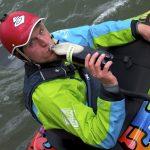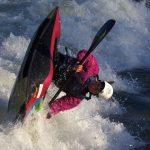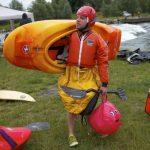As a freestyle kayaker, a kayak instructor and a physiotherapist, I chose exactly this topic for my Bachelor thesis. Specifically, to find out which injuries are most common in German canoe freestyle athletes, what they do to prevent injury and what could be done better.
My survey with German freestyle athletes about their training and behaviour before and after training revealed:
- In total, 65% suffered from musculoskeletal discomfort. Of them 44.8% had trouble with their shoulder or neck; 37.9% suffer from back pains or injuries; 24.1% had trouble with either their elbow, forearm or wrist; and 10.3% indicated discomfort in their legs, ankles or feet.
- The most most popular preventative measures were a bent paddle shaft (48.3%), then a warm up program (34.5%), flexibility training and weight lifting training (both 31%) and technique training (24,1 %). Only 6,9 % do a coordination training. Even 20.7% don’t use any preventative measures at all.
- No matter what equipment in use – Jörn Hüsch prevents injuries by the use of a crank shaft!
So what does the literature give as advice for preventing injury? Well, you might work on almost any aspect of your paddling and lifestyle, including: weight lifting; flexibility training; proprioception training; specific technique training to prevent overloads; an individual workout plan with sufficient time for regeneration; mental and psychological techniques for stress reduction; adjustment of nutrition and the use of ergonomic sports equipment (paddles and boats/seats).
In other sports, neuromuscular warm up programs are a quick an effective way to reduce the risk of injury. On top of that, they also improve the performance of the athletes! They tend to include three main parts: a general warm up (to get your heart pumping); proprioception, balance and strengthening exercises (often plyometric); and high-intensity sport specific movements such as forward and backward strokes including sprints and changes of direction. So here I’ve put together a neuromuscular warm up program for freestyle:



